Section 6 Workplace Satisfaction
6.1 Introduction
Four main subtopics in this section cover women’s job satisfaction, satisfaction with workplace benefits, experiences with workplace discrimination, and the positive and negative factors affecting career advancement. Questions included in this section had varying levels of instruction for respondents. Those instructions are included in the data visualizations as expressed in the survey.
The following graphs illustrate information about different groups based on the size of their employer, wage income, race / ethnicity, and race / ethnicity and wage income together. We only show the results we are sure are real, not just by chance. However, some of the visual differences we between the groups may be due to chance. Also, just because we don’t see a difference between two groups, it doesn’t mean there isn’t a real difference. It just means we don’t have enough information to be sure.
6.2 Key Findings
- Women’s level of satisfaction with their employers relating to advancement opportunities was the only aspect of satisfaction with their employer that varied consistently across all disaggregations.
- When rating different aspects of satisfaction with their jobs, women from different backgrounds reported different satisfaction levels the most consistently when rating their paid time off and flexible working opportunities.
- When rating different aspects of satisfaction with their employers’ commitment to workplace equity, women’s responses varied by all the disaggregations examined except age / generation for commitment to gender equity, handling of workplace complaints, and hiring and advancement policies.
- Out of all of the benefits assessed, women from different backgrounds reported the most consistent variation in satisfaction levels across demographic groups with continuing education opportunities.
- Gender discrimination showed the highest variation in how various groups of women reported experiencing or witnessing it at work, among all the assessed forms of discrimination.
- Analysts found the most consistent variation across demographic groups in how age impacted their career advancement.
6.3 Satisfaction with Work
6.3.1 Introduction
This section contains survey results on respondents’ satisfaction with their employer, job roles and responsibilities, and employer’s approach to workplace equity.
6.3.2 Key Findings
- Women’s level of satisfaction with their advancement opportunities was the only aspect of satisfaction with their employer that varied consistently across all disaggregations.
- When rating different aspects of satisfaction with their jobs, women from different backgrounds reported different satisfaction levels the most consistently when rating their paid time off and flexible working opportunities.
- When rating different aspects of satisfaction with their employers’ commitment to workplace equity, women’s responses varied by all of the disagregations examined except age / generation for commitment to gender equity, handling of workplace complaints, and hiring and advancement policies.
6.3.3 Employer Satisfaction


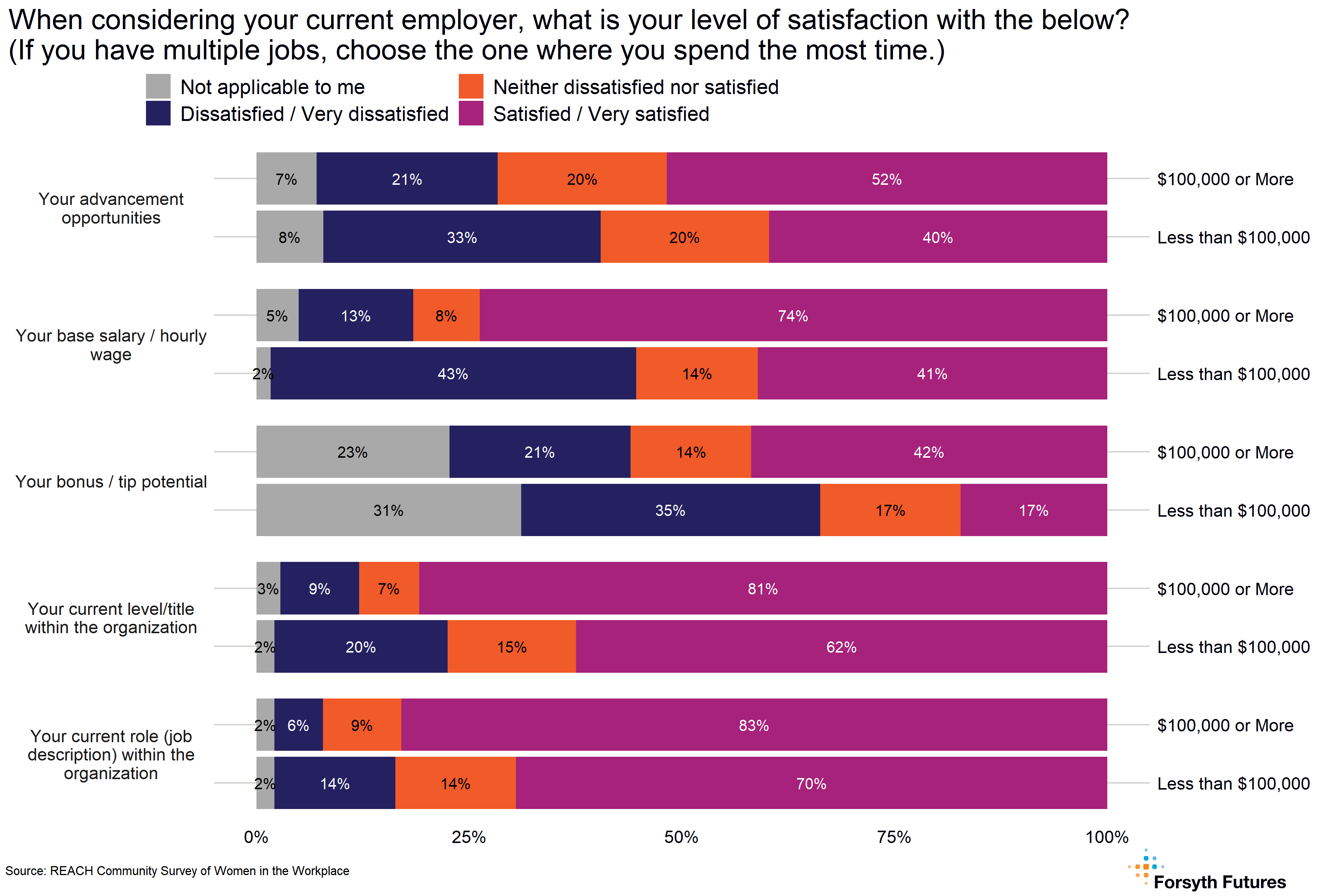
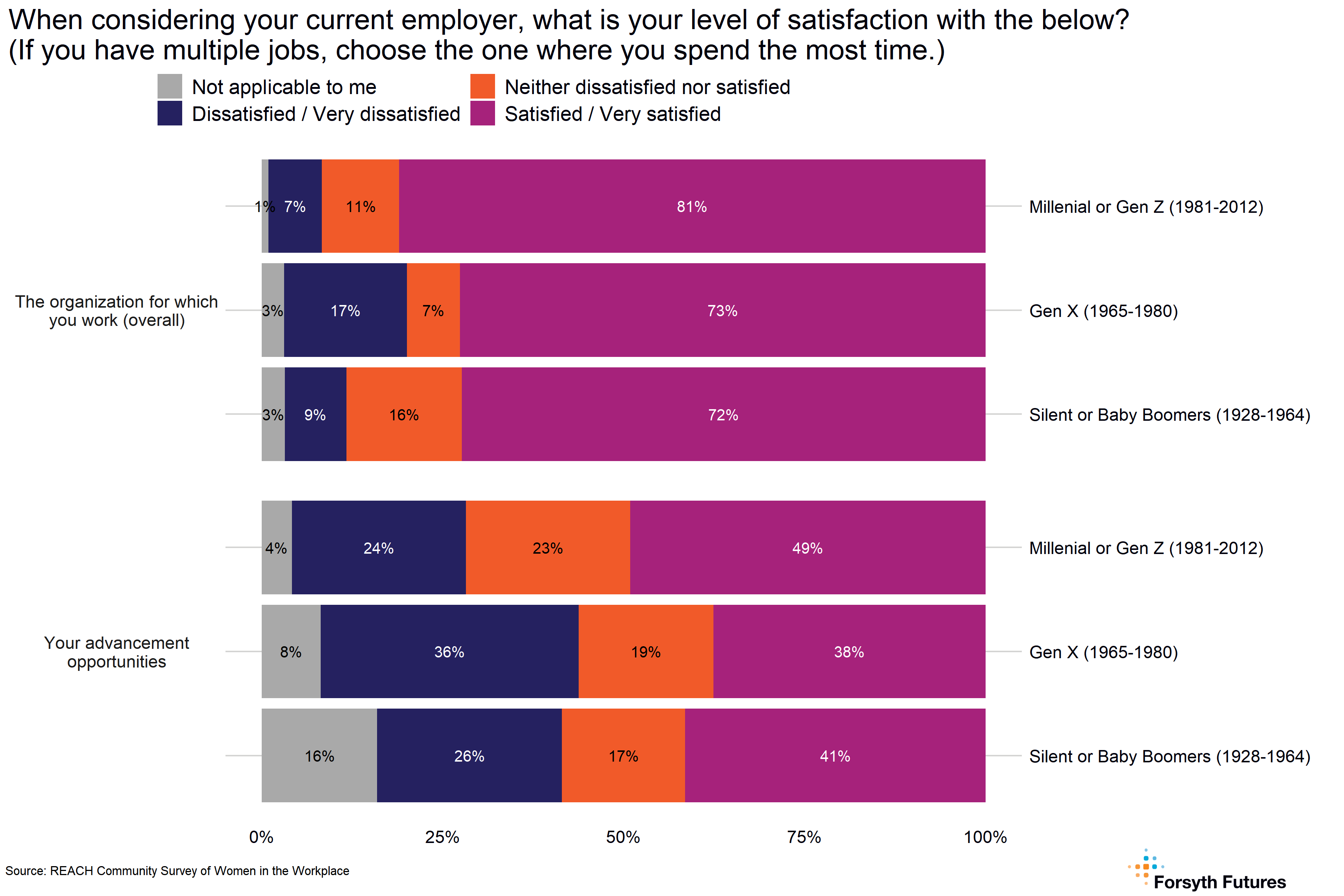
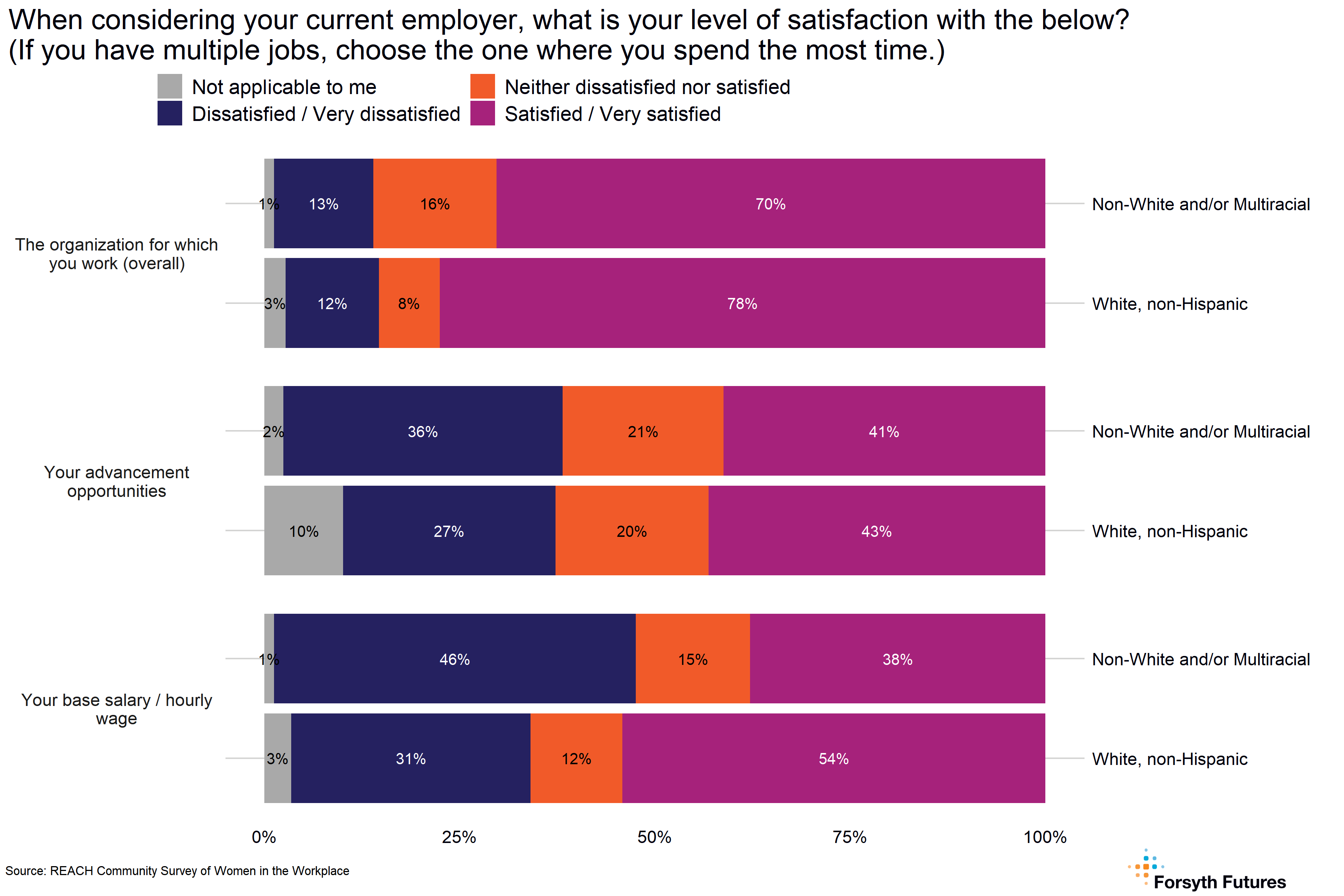
Among the disaggregations, analysts found the following statistically significant relationships with the components of employer satisfaction:
- size of employer
- organization overall
- advancement opportunities
- base salary / hourly wage
- bonus / tip potential
- current level / title
- current role
- professional development opportunities
- relationship with immediate supervisor
- race / ethnicity and wage income together
- advancement opportunities
- base salary / hourly wages
- bonus / tip potential
- current level / title
- current role
- wage income
- advancement opportunities
- base salary / hourly wages
- bonus / tip potential
- current level / title
- current role
- age / generation
- organization overall
- advancement opportunities
- race / ethnicity
- organization overall
- advancement opportunities
- base salary / hourly wage
The level of satisfaction with advancement opportunities was the only aspect that consistently had statistically significant relationships with all of the disaggregations.
6.3.4 Job Satisfaction



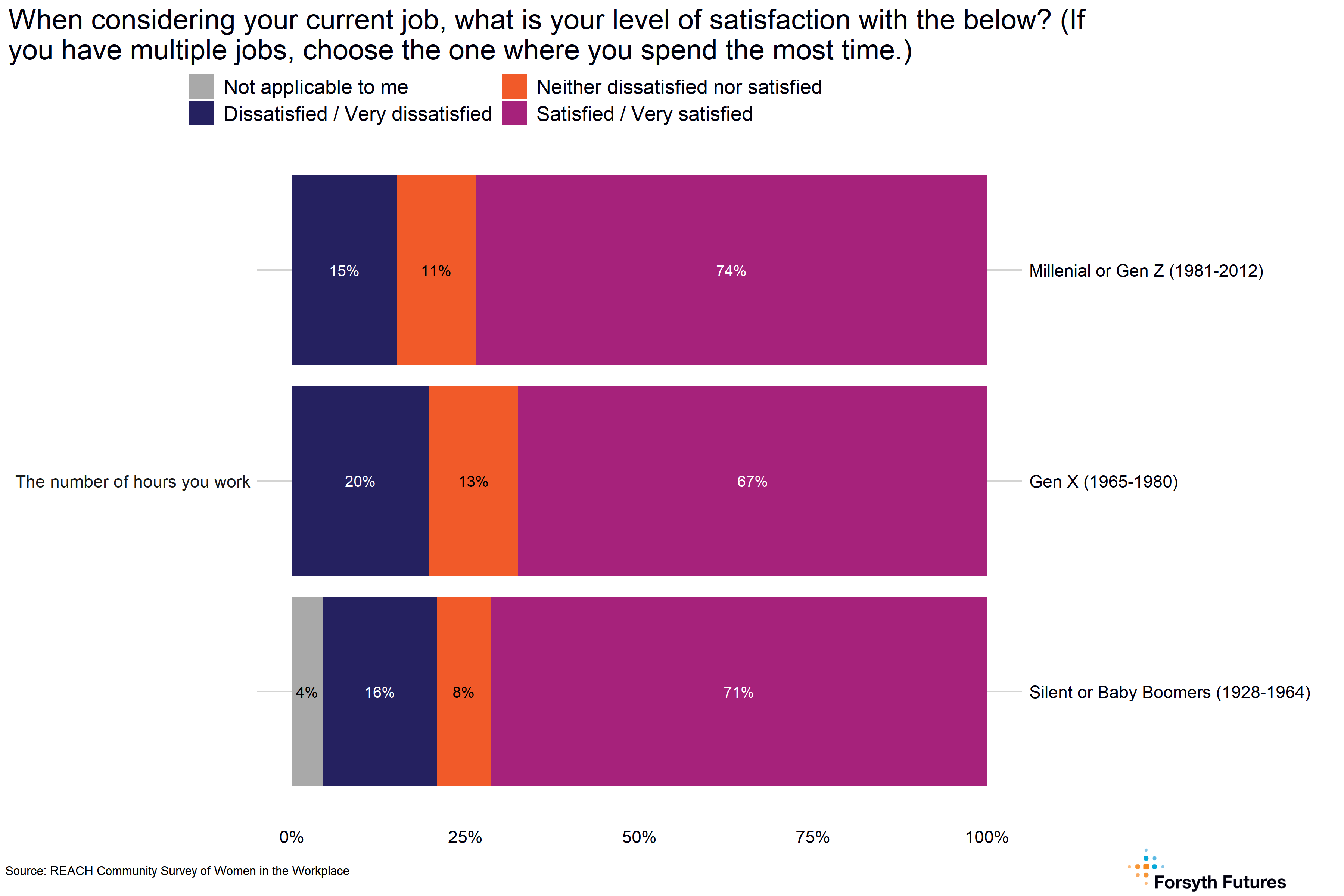
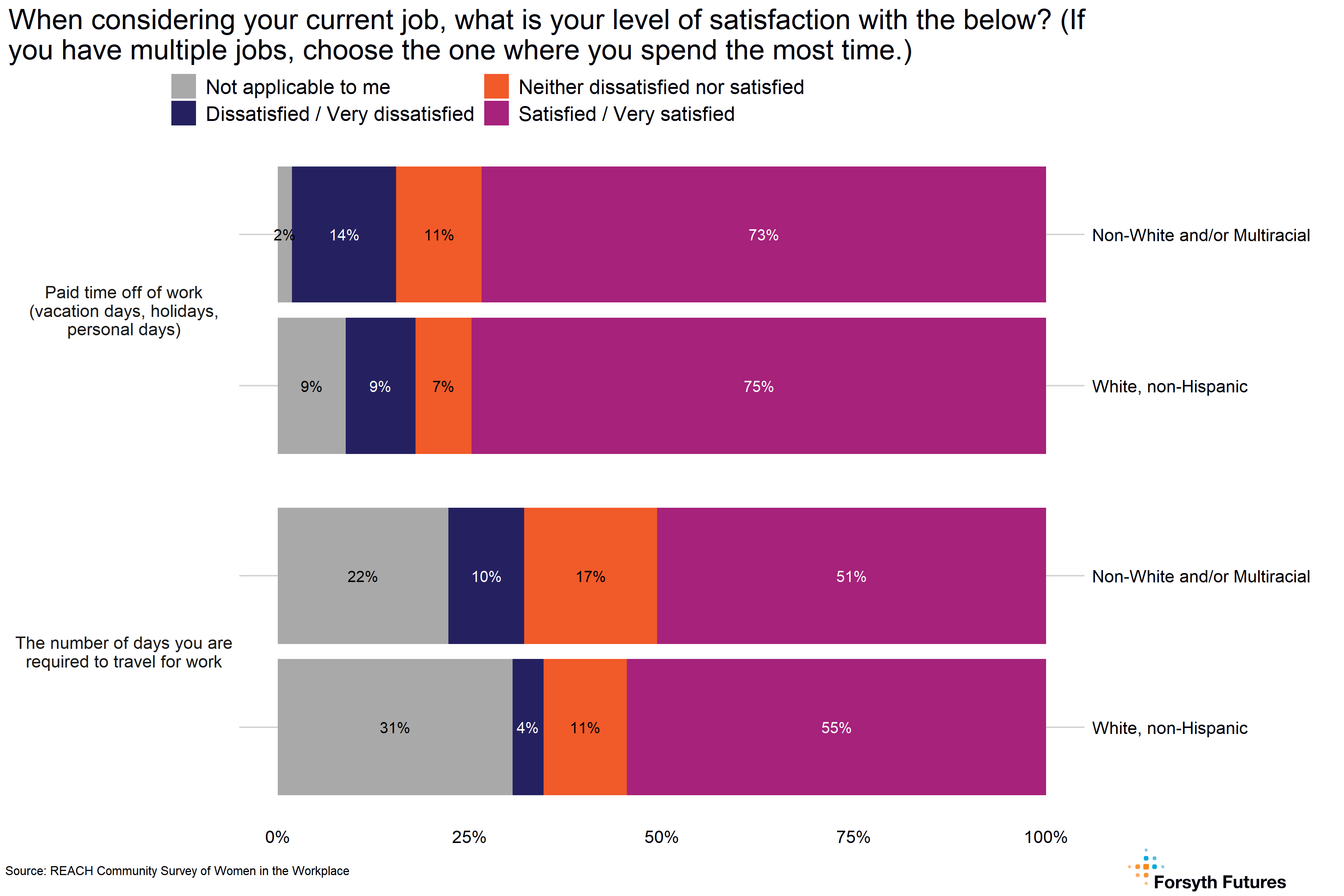
Among the disaggregations, analysts found the following statistically significant relationships between the components of job satisfaction with current occupation:
- size of employer
- paid time off
- hours worked
- commute
- race / ethnicity and wage income together
- paid time off
- travel days
- wage income
- paid time off
- flexibility with physical location
- travel days
- age / generation
- hours worked
- race / ethnicity
- paid time off
- travel days
There were not any components of job satisfaction with current occupation that consistently had a significant relationship across the disaggregations, however, paid time off did have a significant relationship across all disaggregations except age / generation.
6.3.5 Job Satisfaction


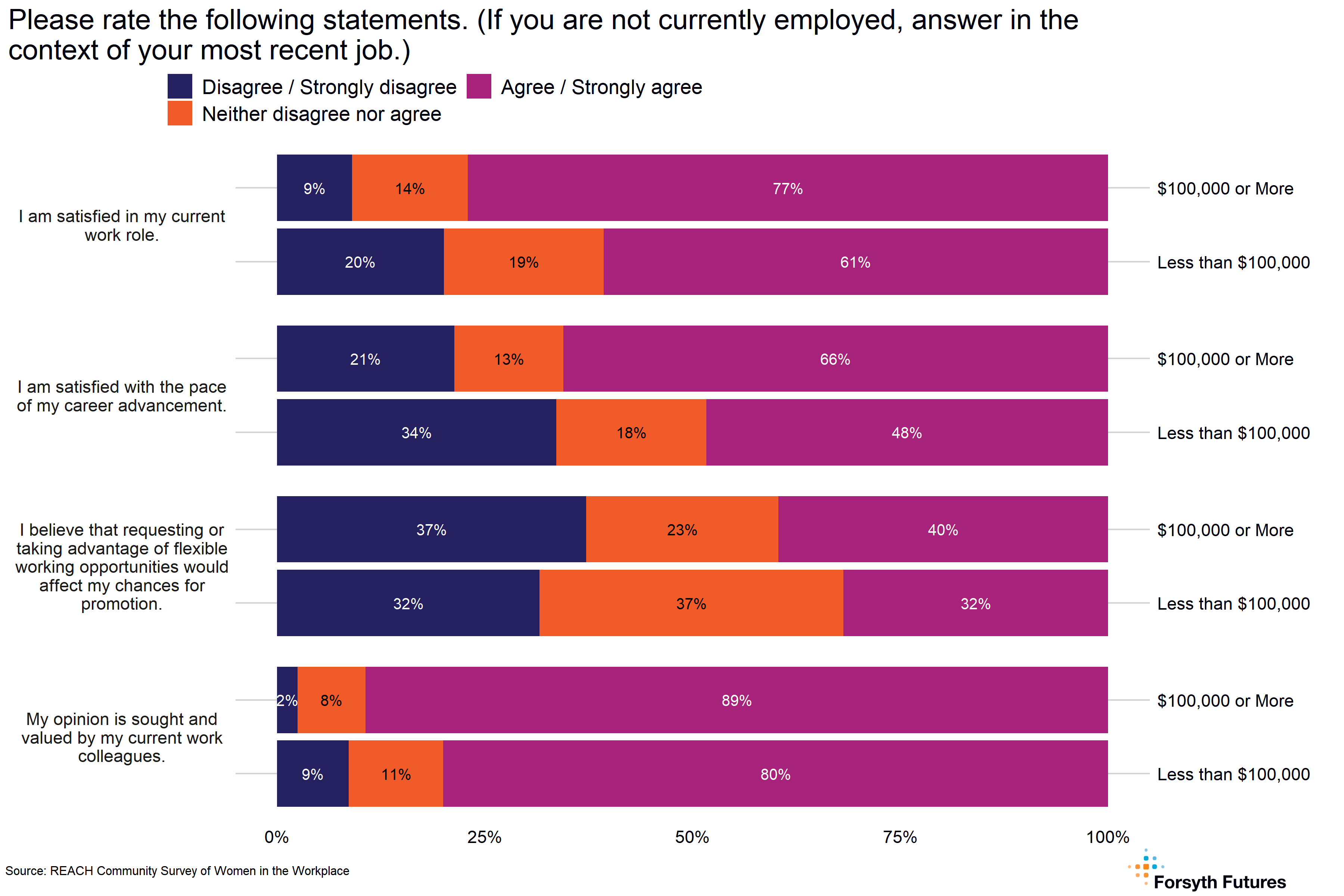
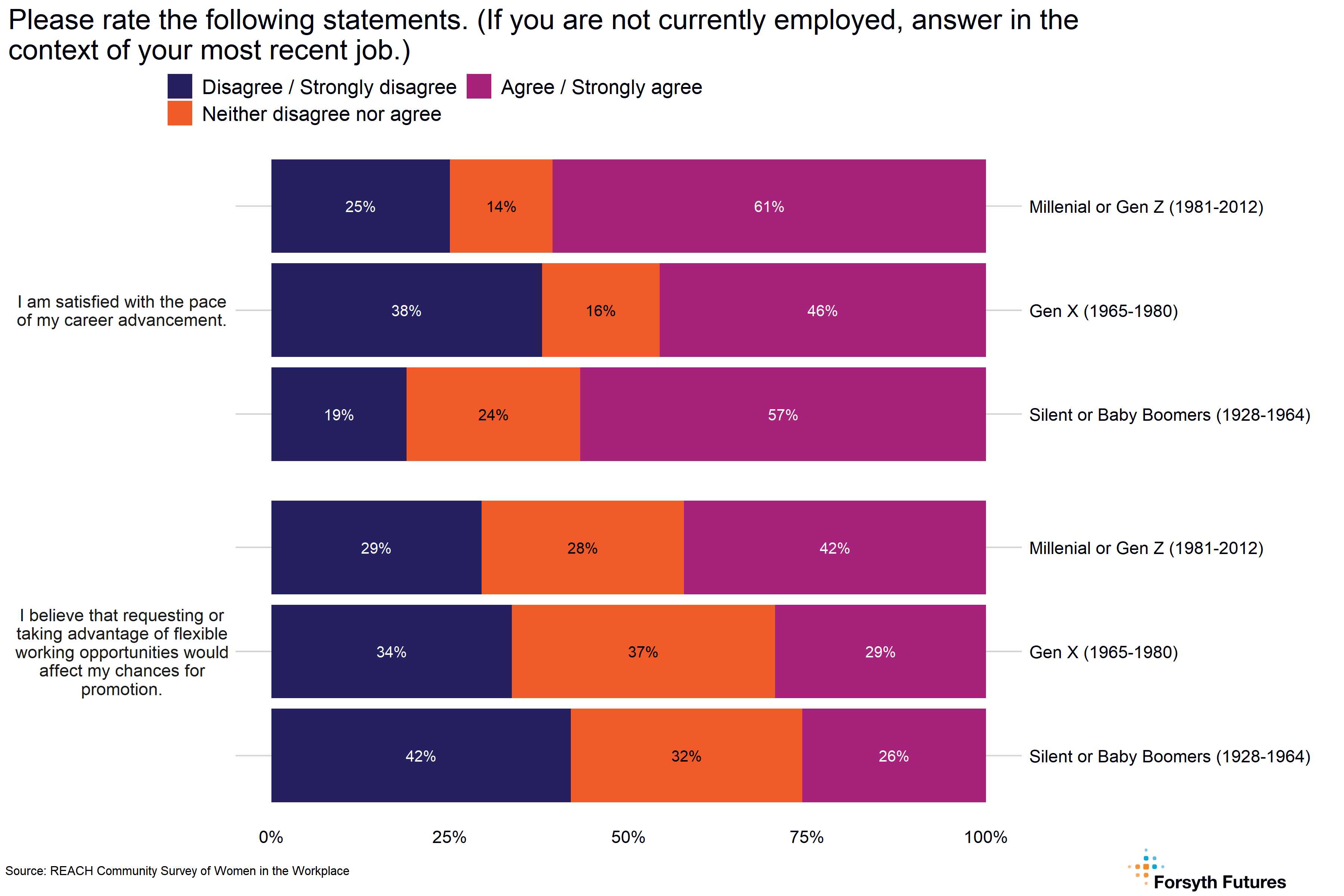
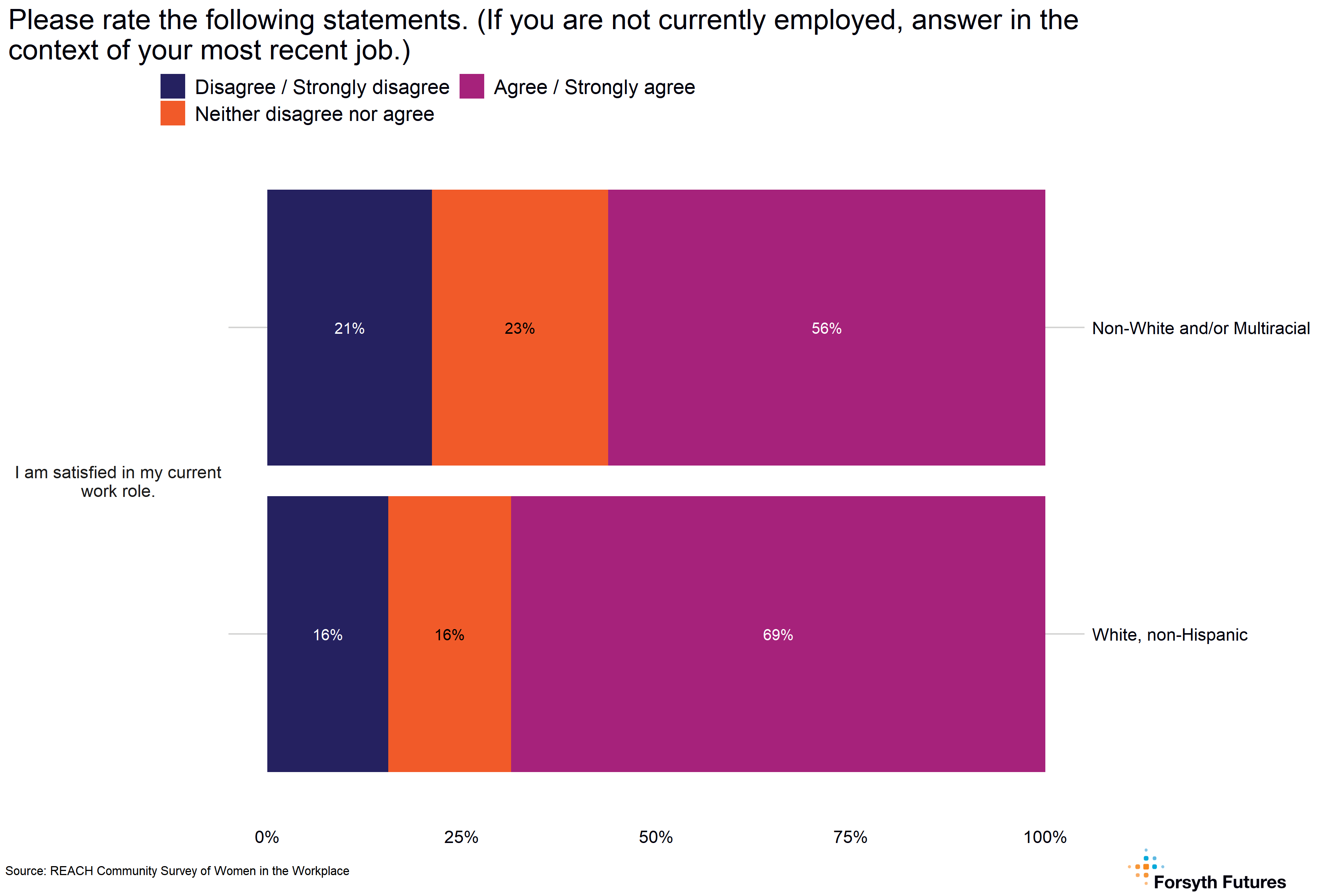
Among the disaggregations, analysts found the following statistically significant relationships with the components of job satisfaction for the most recent job of those who are not currently employed:
- size of employer
- pace of career advancement
- taking advantage of flexible working affecting promotion
- healthy work/life balance
- employer cares about mental health
- race / ethnicity and wage income together
- satisfied in current role
- taking advantage of flexible working affecting promotion
- opinion is sought and valued
- wage income
- satisfied in current role
- pace of career advancement
- taking advantage of flexible working affecting promotion
- opinion is sought and valued
- age / generation
- pace of career advancement
- taking advantage of flexible working affecting promotion
- race / ethnicity
- satisfied in current role
There were not any components of job satisfaction for the most recent job of those who are not currently employed that consistently had a significant relationship across the disaggregations. However, taking advantage of flexible working affecting promotion did have a significant relationship across all disaggregations except race / ethnicity.
6.3.6 Workplace Equity Satisfaction



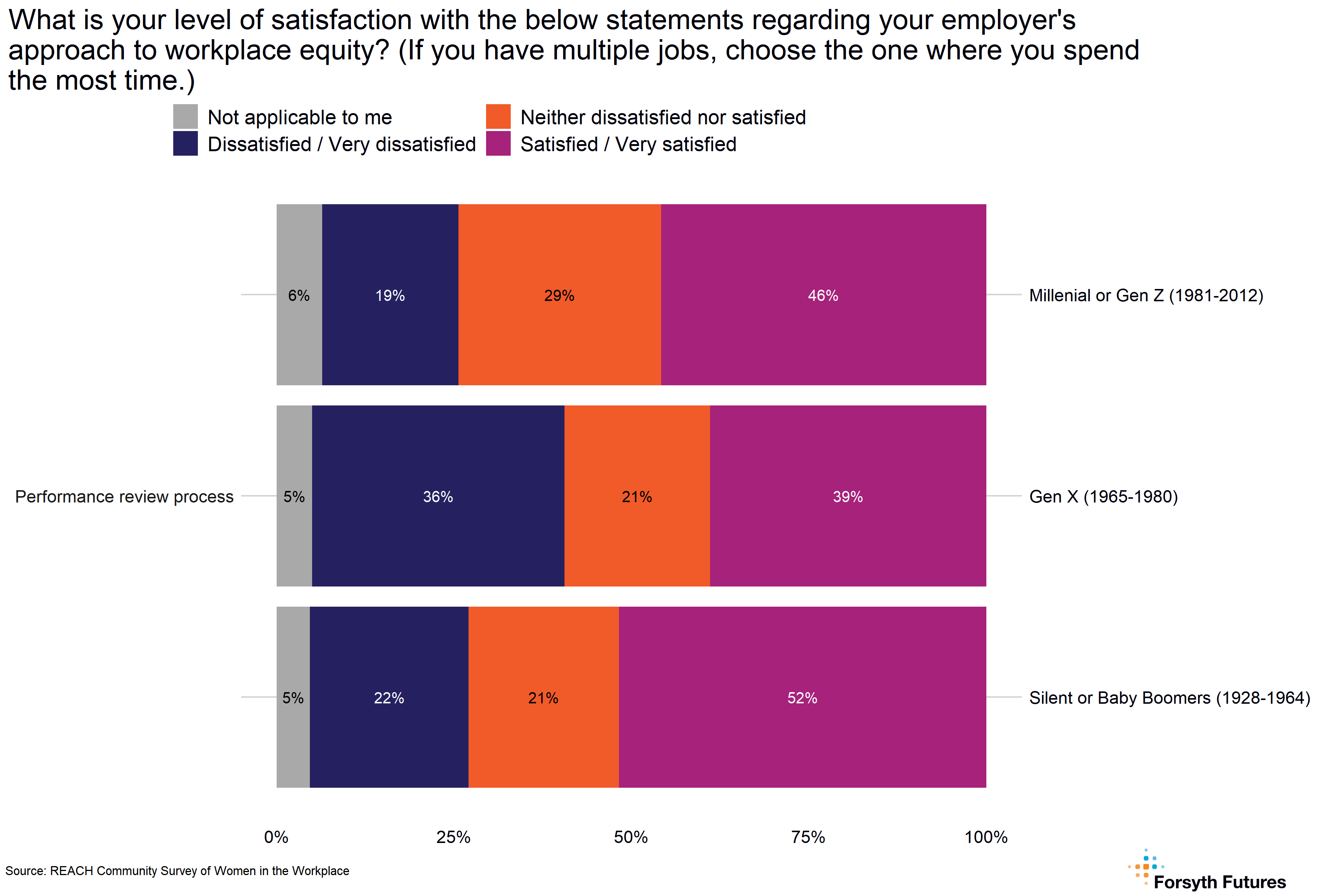
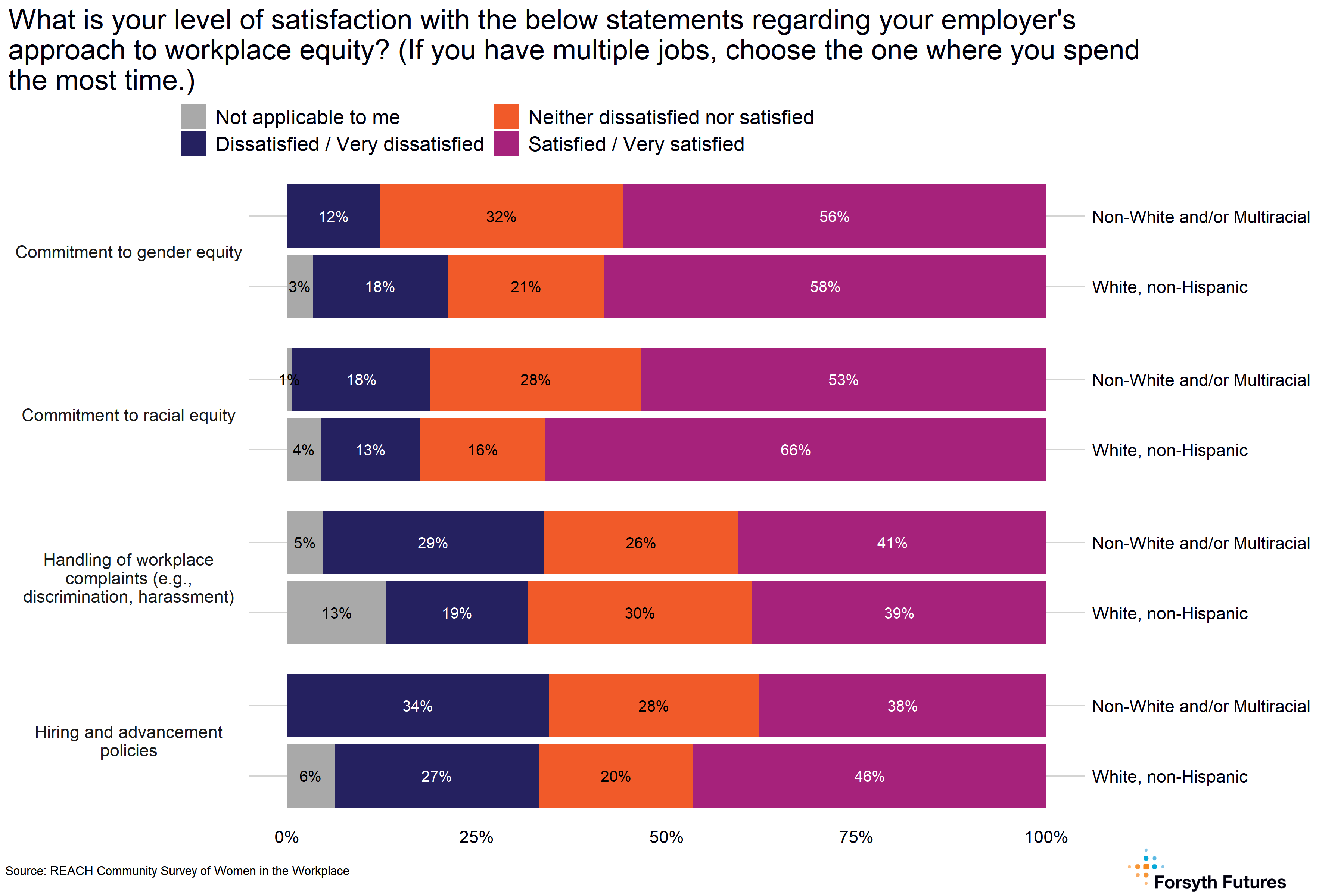
Among the disaggregations, analysts found the following statistically significant relationships between the level of satisfaction with the statements regarding one’s employer’s approach to workplace equity:
- size of employer
- commitment to age / generational inclusion
- commitment to gender equity
- handling of workplace complaints
- hiring and advancement policies
- performance review process
- race / ethnicity and wage income together
- commitment to gender equity
- commitment to racial equity
- handling of workplace complaints
- hiring and advancement policies
- wage income
- commitment to gender equity
- handling of workplace complaints
- hiring and advancement policies
- age / generation
- performance review process
- race / ethnicity
- commitment to gender equity
- commitment to racial equity
- handling of workplace complaints
- hiring and advancement policies
There were not any components of level of satisfaction with the statements regarding one’s employer’s approach to workplace equity that consistently had a significant relationship across the disaggregations. However, commitment to gender equity, handling of workplace complaints, and hiring and advancement policies did have a significant relationship across all disaggregations except age / generation.
6.4 Satisfaction with Benefits
6.4.1 Introduction
The following section assesses women’s feelings about workplace benefits in two categories. The first is schedule flexibility, and the second covers more comprehensive benefits such as health care, child care, parental leave, and paid time off.
6.4.2 Key Findings
- Out of all the benefits assessed, women from different backgrounds reported the most consistent variation in satisfaction levels across demographic groups with continuing education opportunities.
6.4.3 Workplace Flexibility Benefits


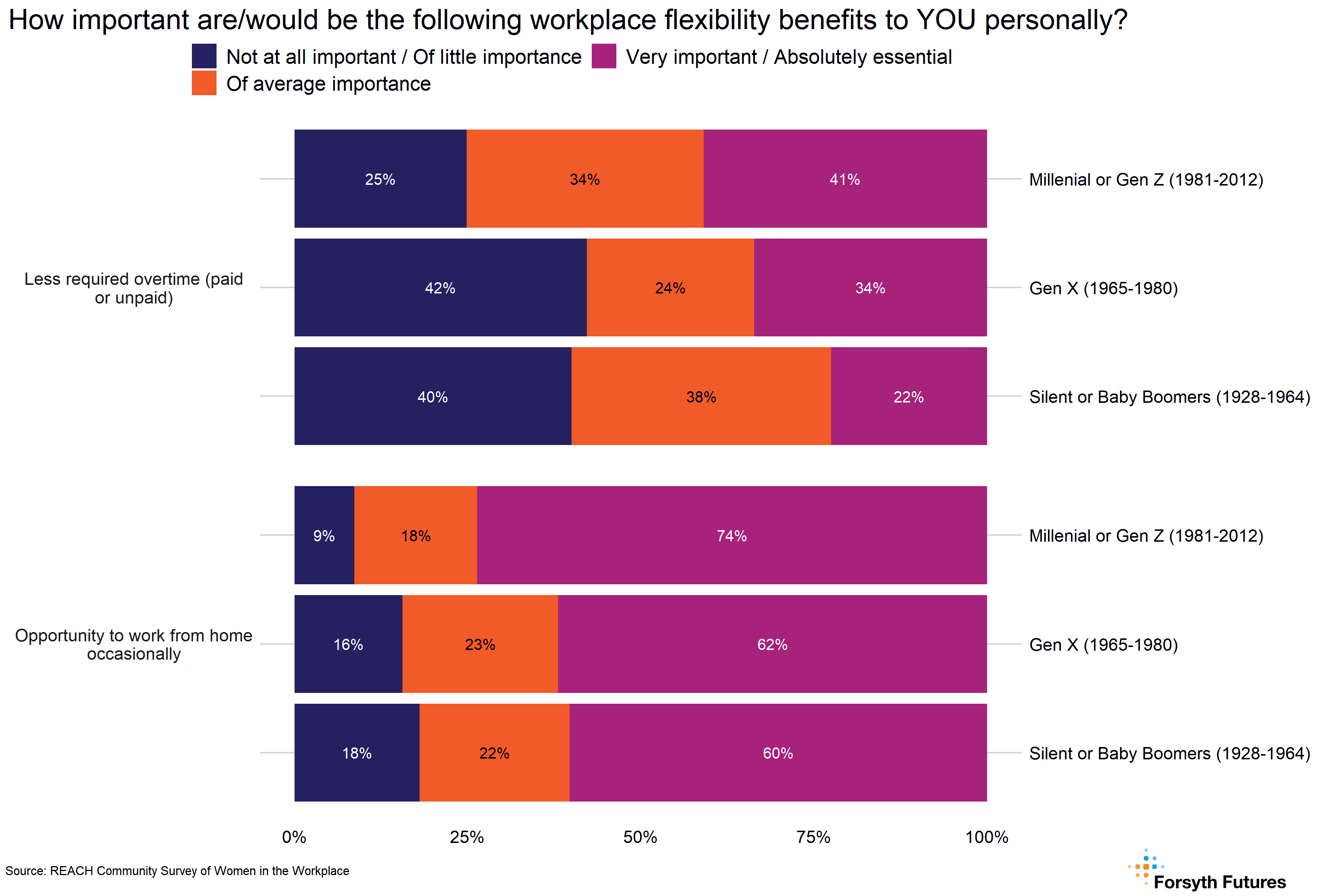
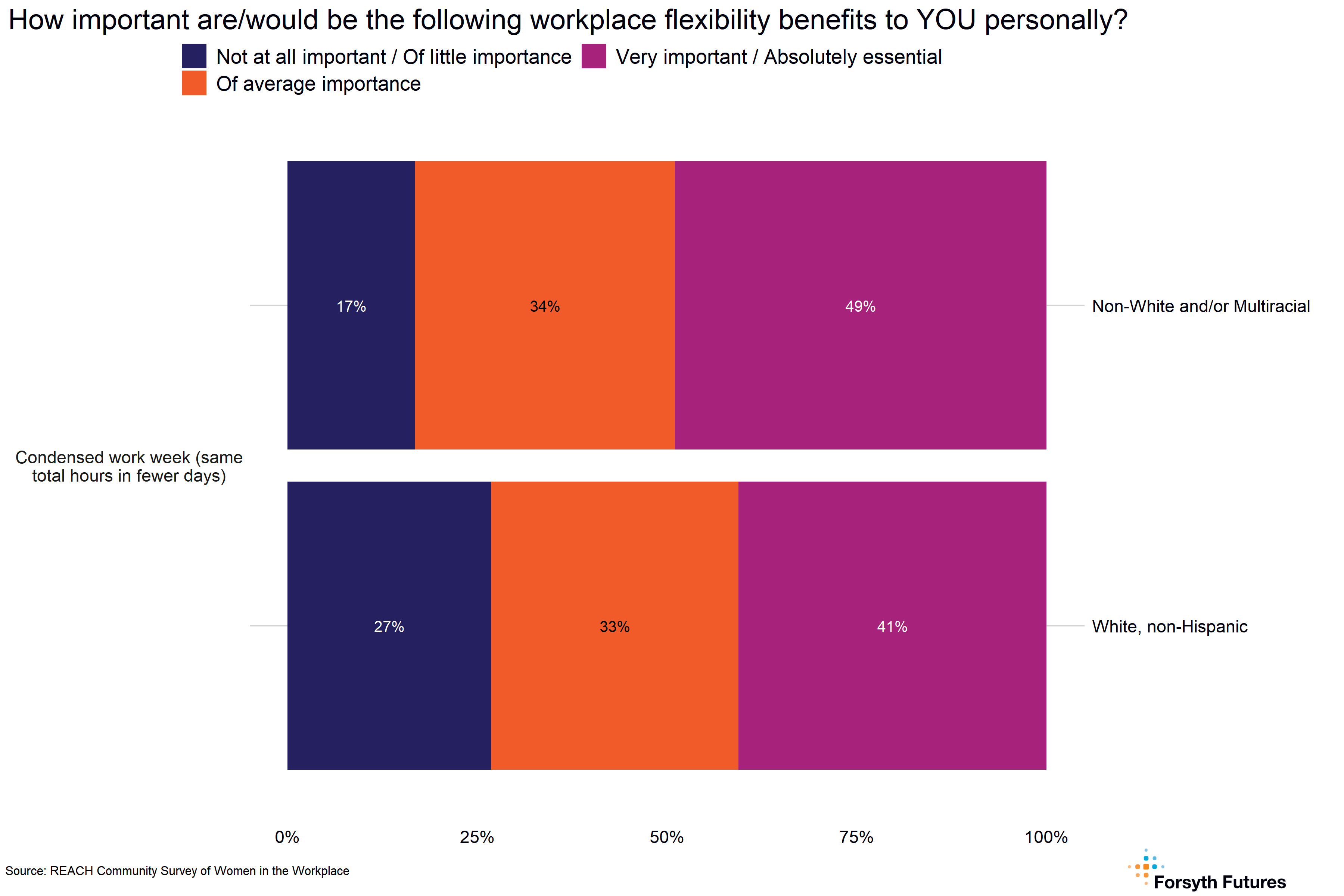
Among the disaggregations, analysts found the following statistically significant relationships between workplace flexibility benefits:
- size of employer
- ability to work reduced hours
- race / ethnicity and wage income together
- condensed work week
- age / generation
- less required overtime
- opportunity to work from home occasionally
- race / ethnicity
- condensed work week
There were not any workplace flexibility benefits that consistently had a significant relationship across the disaggregations.
6.4.4 Workplace Benefits


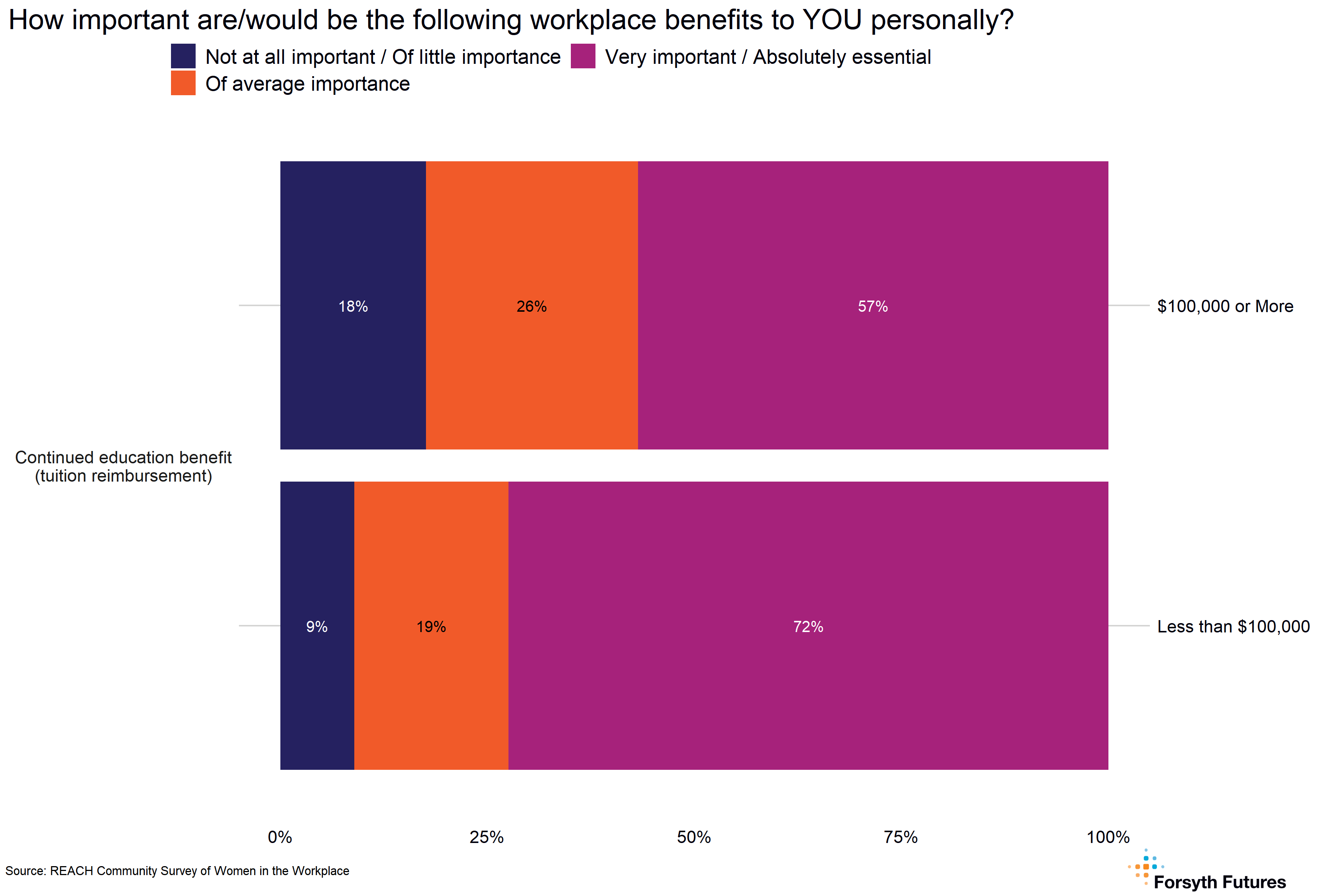
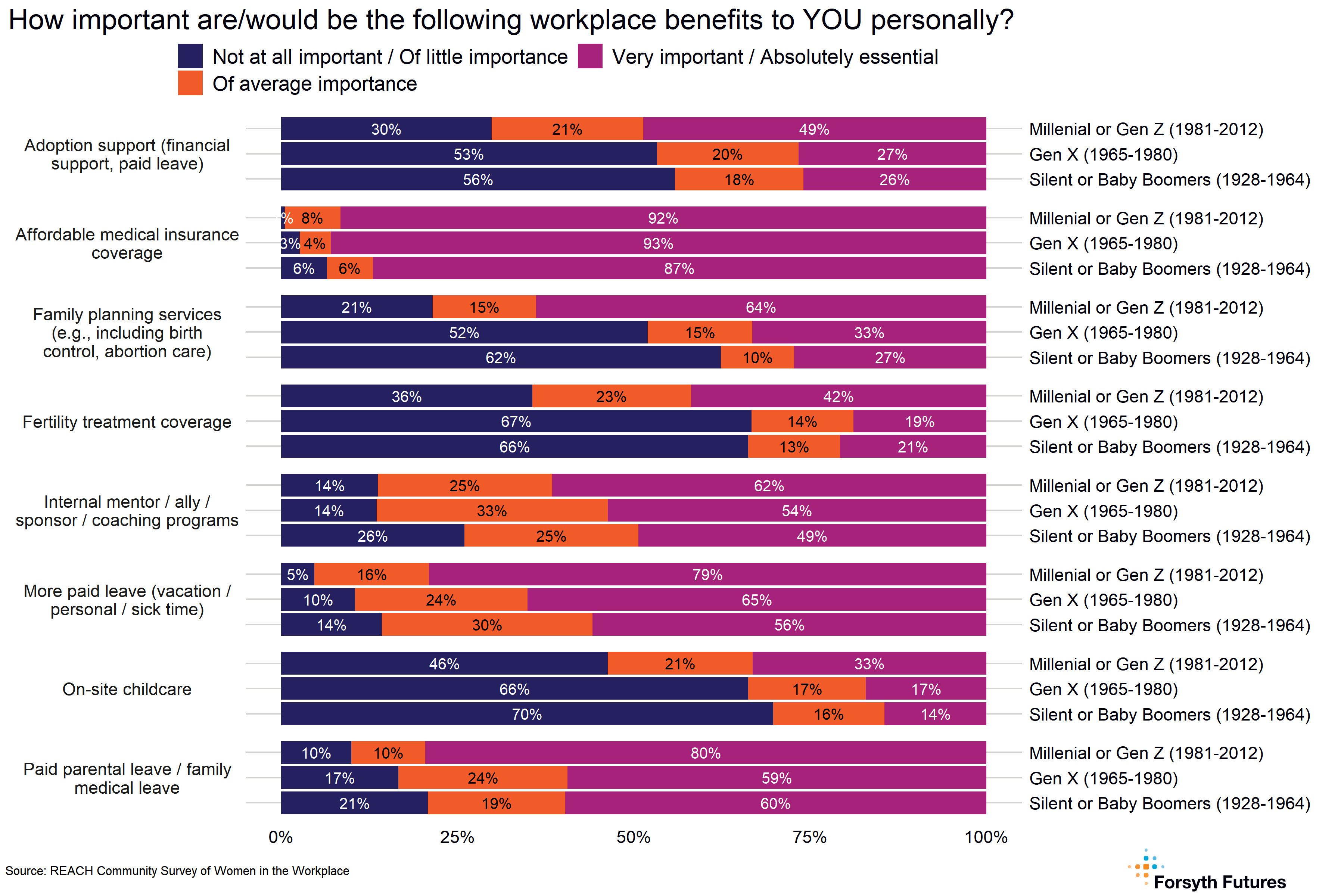
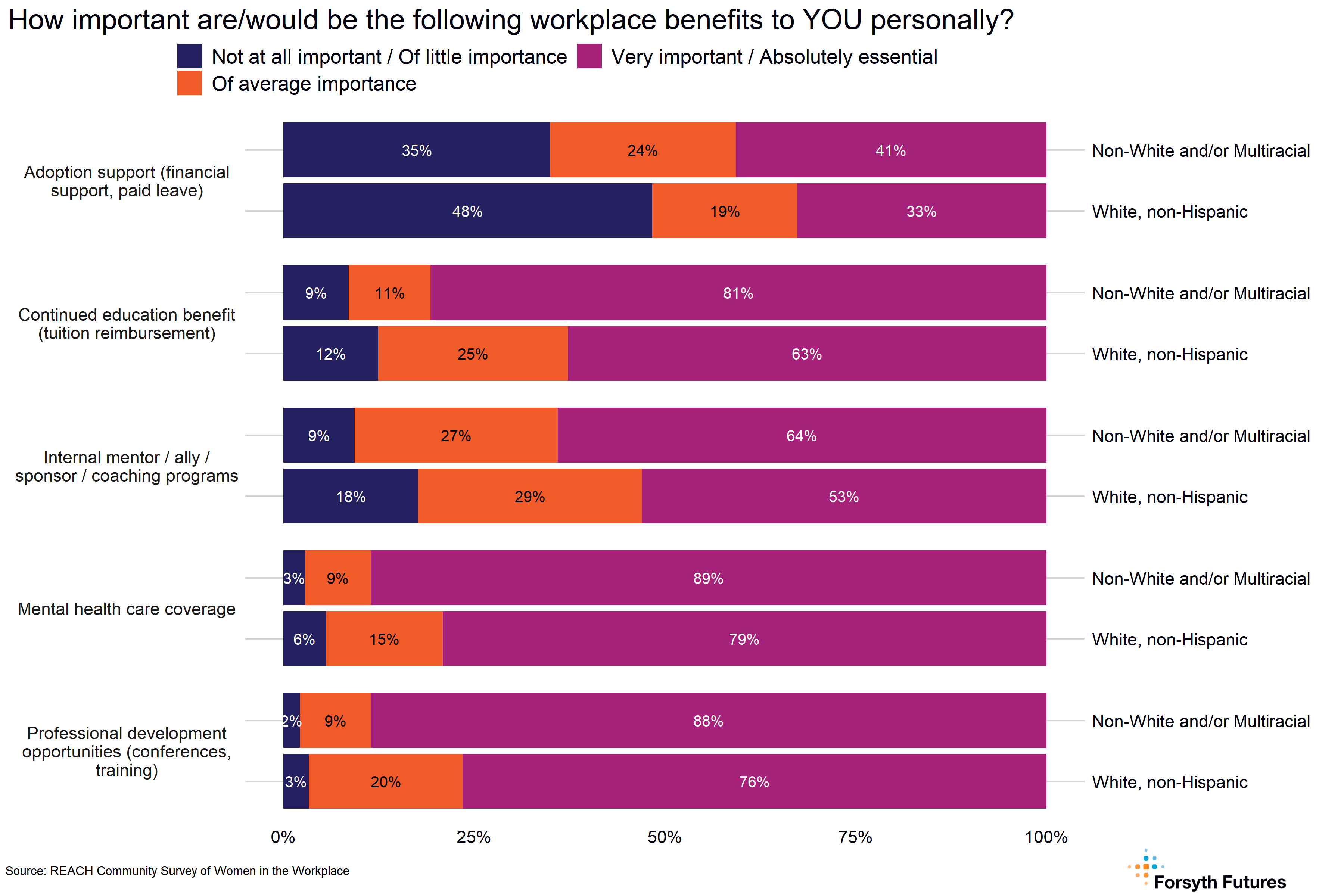
Among the disaggregations, analysts found the following statistically significant relationships between workplace benefits:
- size of employer
- affordable medical insurance coverage
- continued education
- Flexible Spending Account
- race / ethnicity and wage income together
- continued education
- wage income
- continued education
- age / generation
- adoption support
- affordable medical insurance coverage
- family planning services
- fertility treatment coverage
- internal mentor / ally / sponsor / coaching programs
- more paid leave
- on-site child care
- paid parental leave / family medical leave
- race / ethnicity
- adoption support
- continued education
- internal mentor / ally / sponsor / coaching programs
- mental health care coverage
- professional development opportunities
There were not any workplace benefits that consistently had a significant relationship across the disaggregations. However, continued education benefits did have a significant relationship across all disaggregations except age / generation.
6.5 Discrimination
6.5.1 Introduction
This section includes statements concerning whether the survey respondents have witnessed or directly experienced ageism, bullying, gender discrimination, and/or sexual harassment during their careers. Respondents could select all statements that applied to them or indicate that none were true.
6.5.2 Key Findings
- Gender discrimination showed the highest variation in how various groups of women reported experiencing or witnessing it at work, among all the assessed forms of discrimination.
- Analysts found a statistically significant relationship between women’s age and experiencing sexual harassment at work.
- No statistically significant relationships were found between witnessing or directly experiencing bullying or ageism and the disaggregating groups.
6.5.3 Ageism, Bullying, Gender Discrimination, and Sexual Harassment


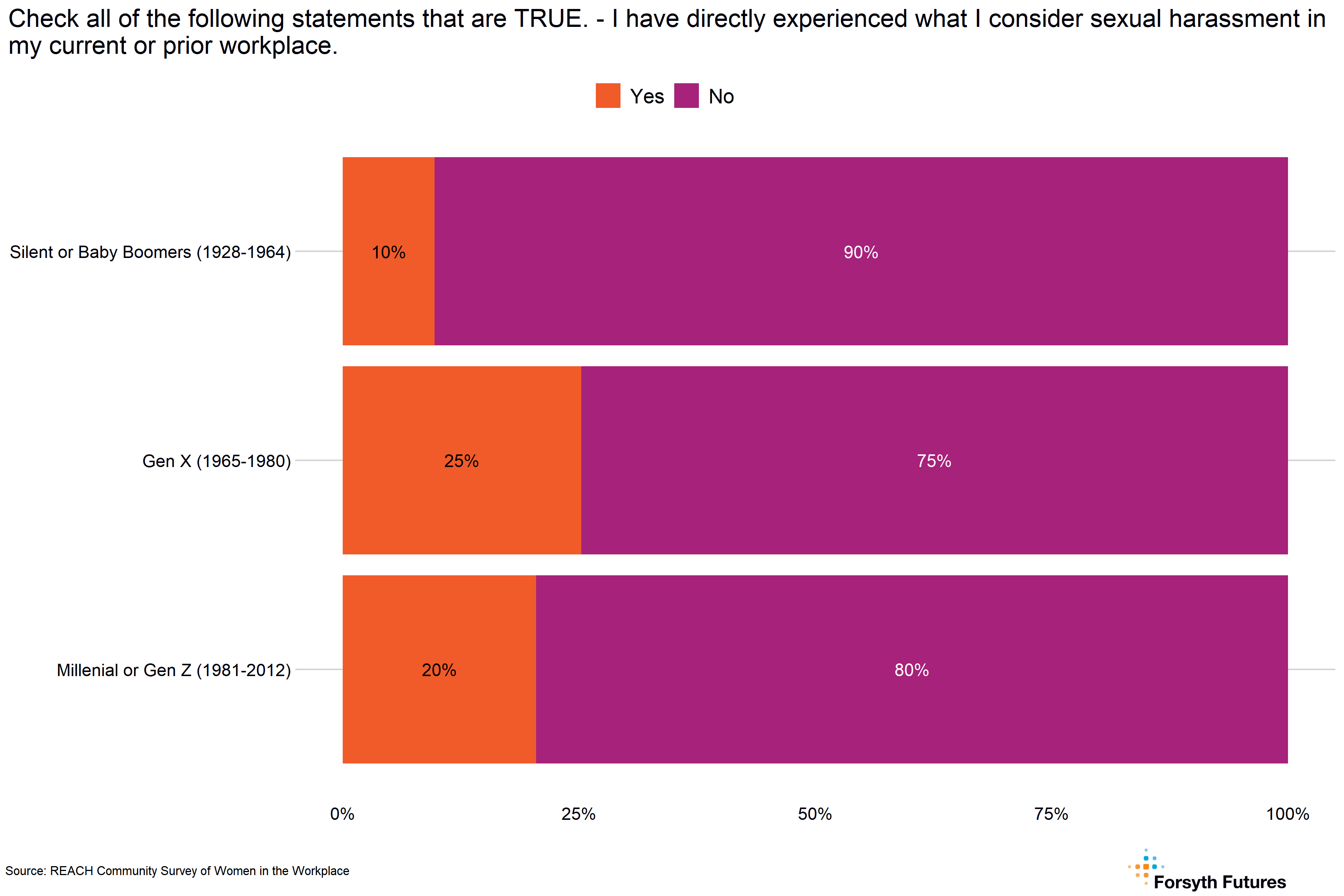
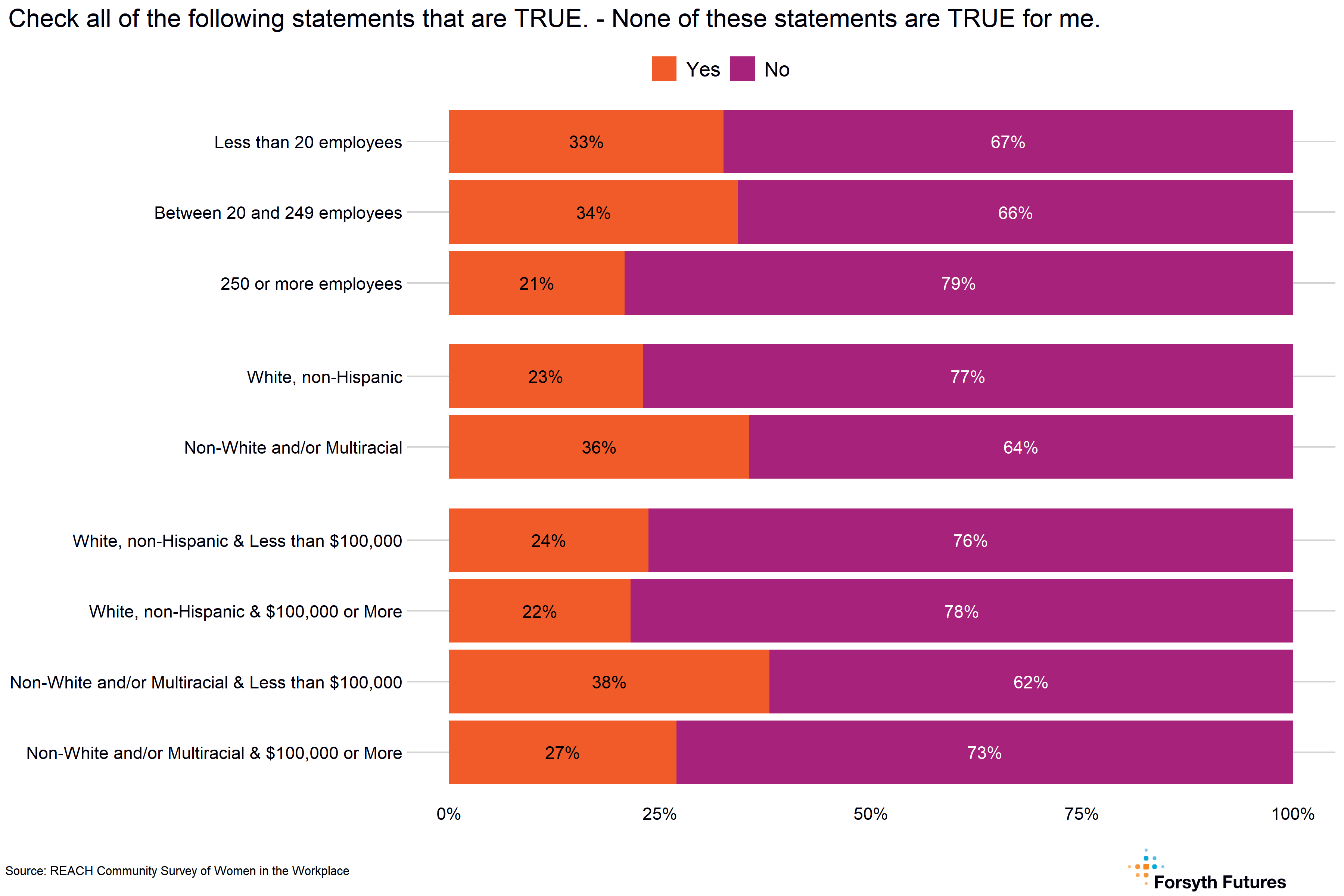
Among the disaggregations, analysts found the following statistically significant relationships between having witnessed and/or directly experienced discrimination:
- age / generation
- witnessed: gender discrimination
- directly experienced: gender discrimination and sexual harassment
- race / ethnicity
- witnessed: gender discrimination
- directly experienced: gender discrimination
- other: none of these statements are true for me
- wage income
- witnessed: gender discrimination
- directly experienced: gender discrimination
- size of employer
- witnessed: gender discrimination
- other: none of these statements are true for me
- race / ethnicity and wage income together
- witnessed: gender discrimination
- directly experienced: gender discrimination
- other: none of these statements are true for me
A statistically significant relationship existed between women’s age and directly experiencing gender discrimination or sexual harassment. Additionally, women who reported directly experiencing gender discrimination varied by race / ethnicity, wage income, and race / ethnicity and wage income together. No statistically significant relationships were found between witnessing or directly experiencing bullying or ageism and the disaggregating groups.
6.6 Factors Influencing Career Advancement and Changing Careers
6.6.1 Introduction
This section evaluates what factors most influence each respondent’s decision to change jobs and which factors have positively or negatively affected their career advancement.
6.6.2 Key Findings
- Analysts found the most consistent variation across demographic groups in how age impacted their career advancement.
6.6.3 Factors Influencing Job Change


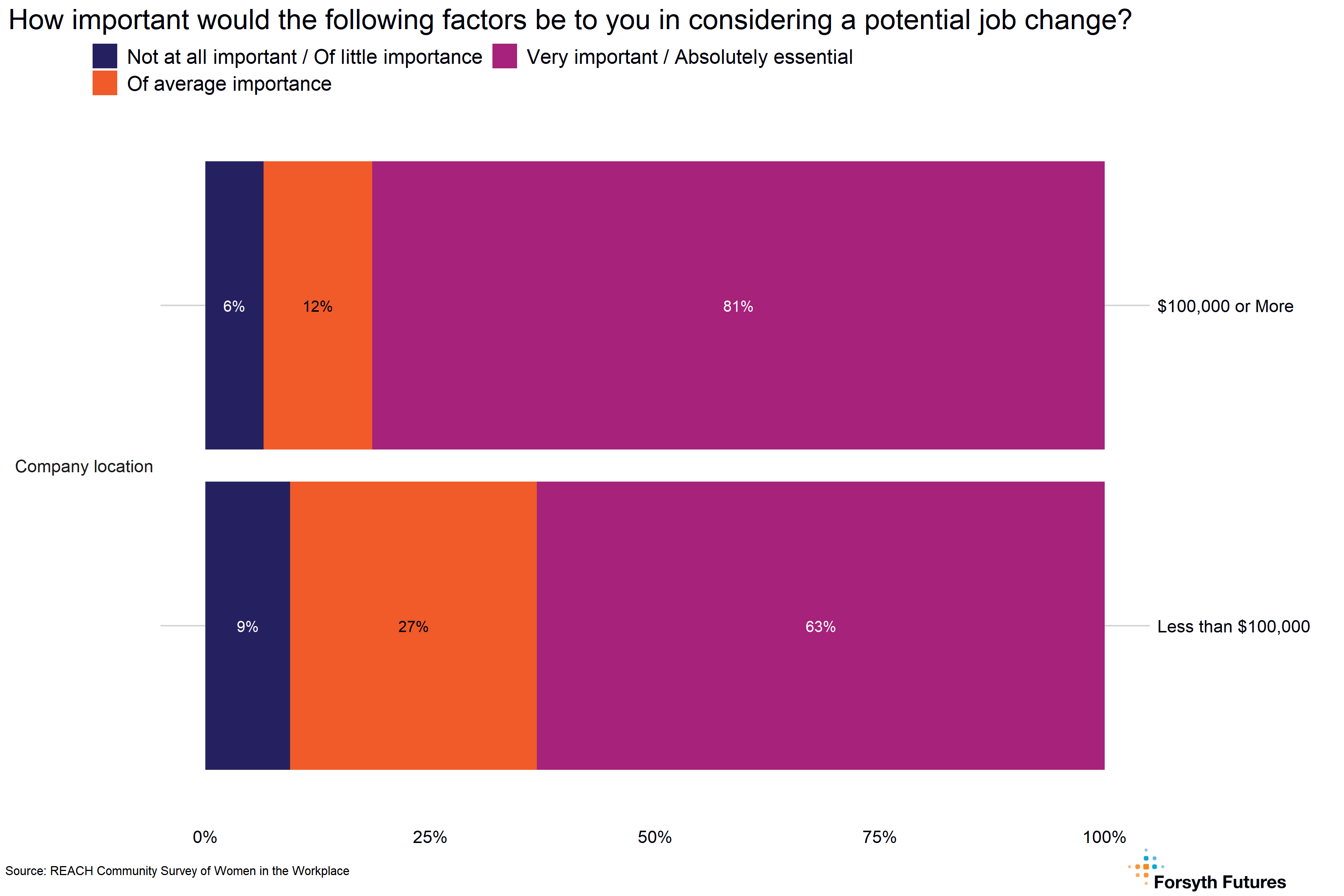
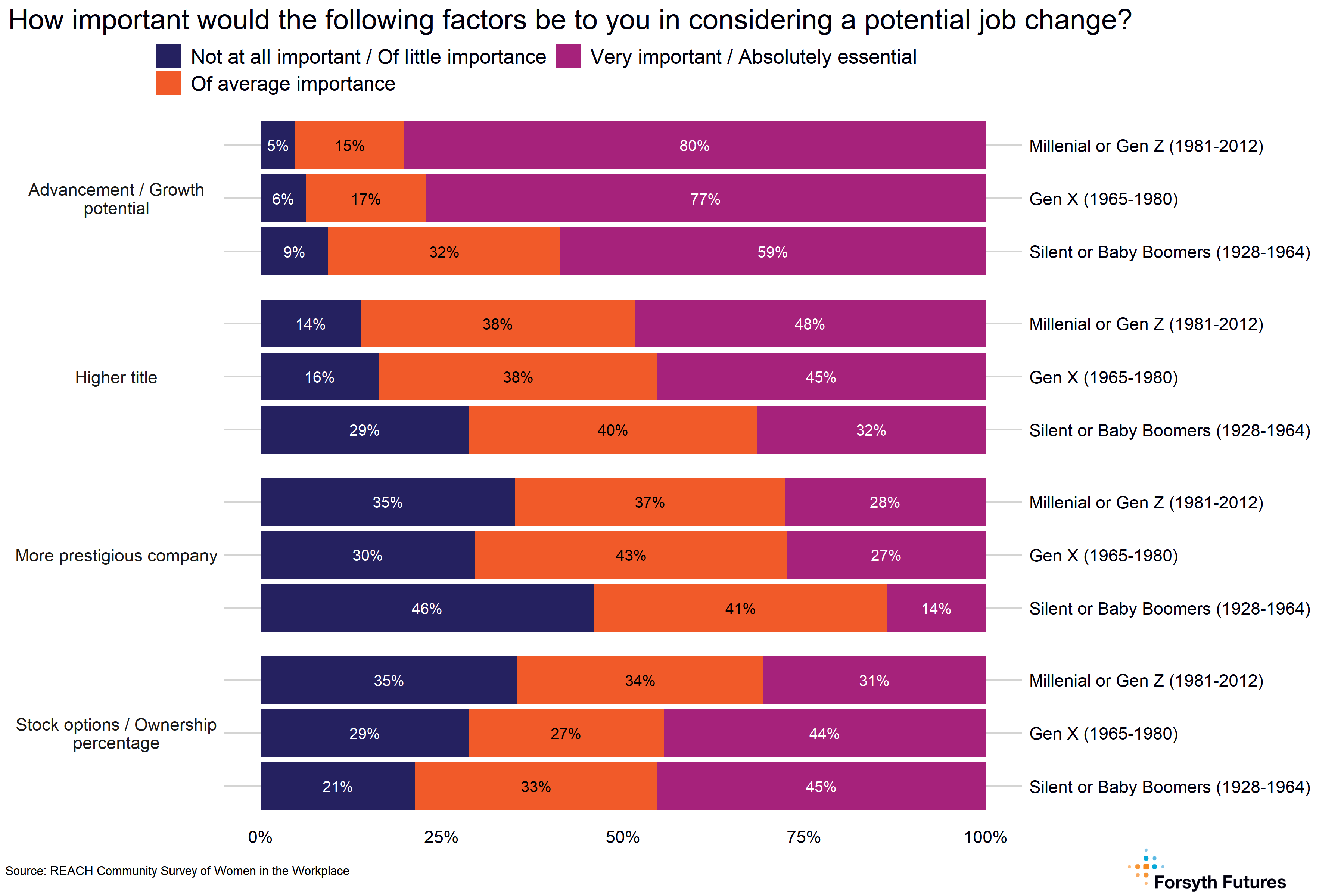
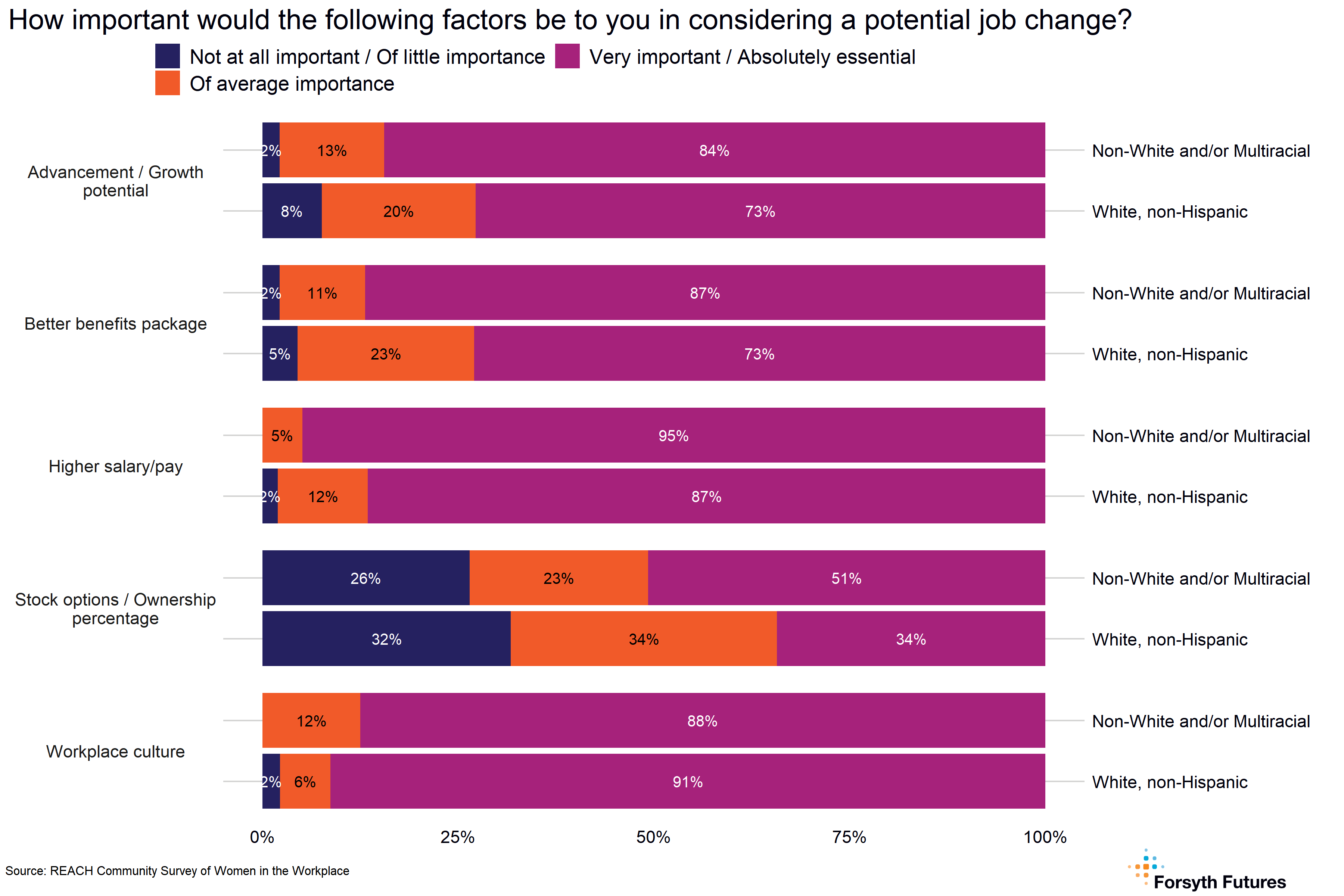
Among the disaggregations, analysts found the following statistically significant relationships between the factors that influence job change:
- size of employer
- advancement / growth potential
- workplace culture
- race / ethnicity and wage income together
- better benefits package
- company location
- more prestigious company
- stock options / ownership percentage
- wage income
- company location
- age / generation
- advancement / growth potential
- higher title
- more prestigious company
- stock options / ownership percentage
- race / ethnicity
- advancement / growth potential
- better benefits package
- higher salary / pay
- stock options / ownership percentage
- workplace culture
There were not any factors influencing job change that consistently had a significant relationship across the disaggregations.
6.6.4 Factors Influencing Career Advancement


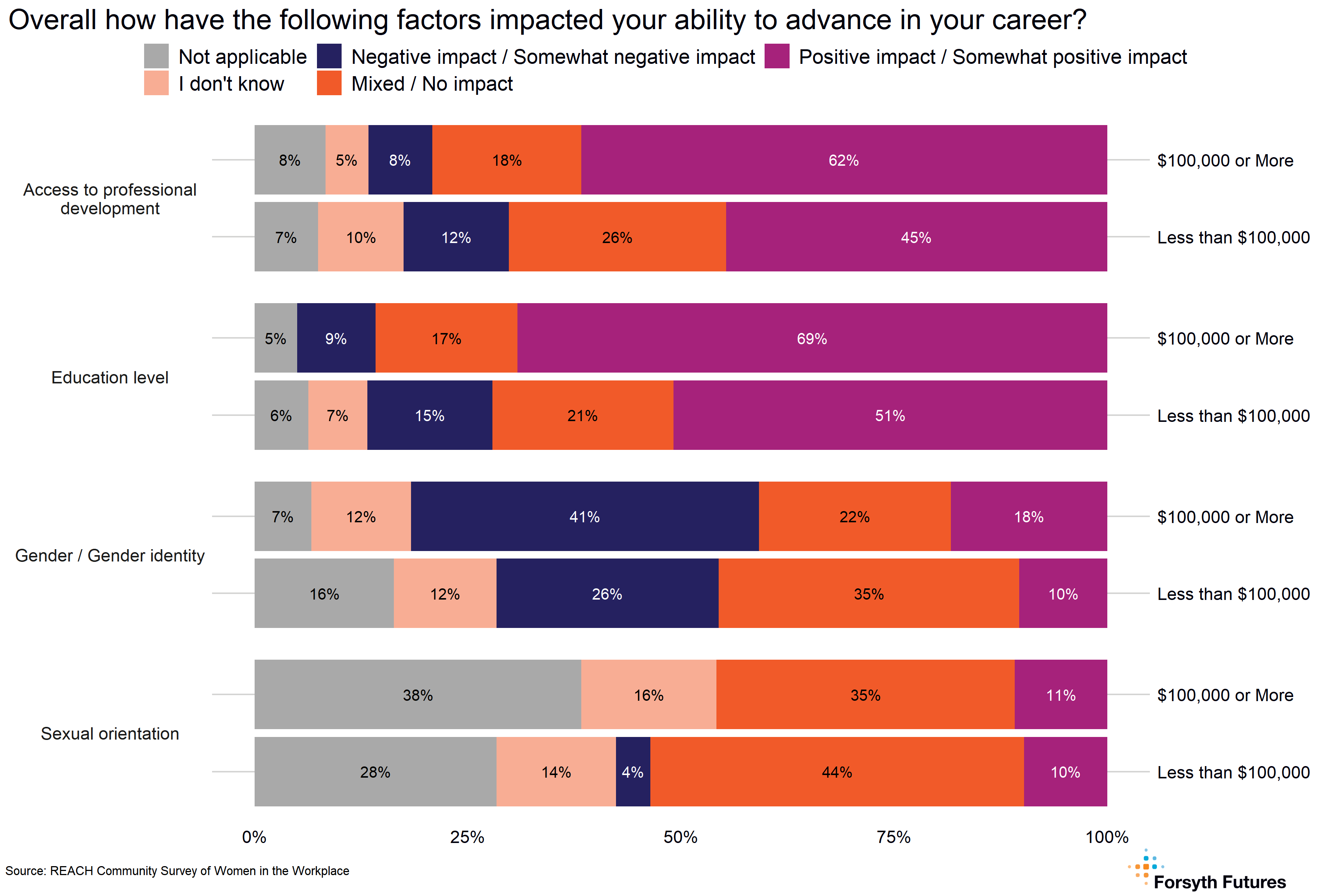
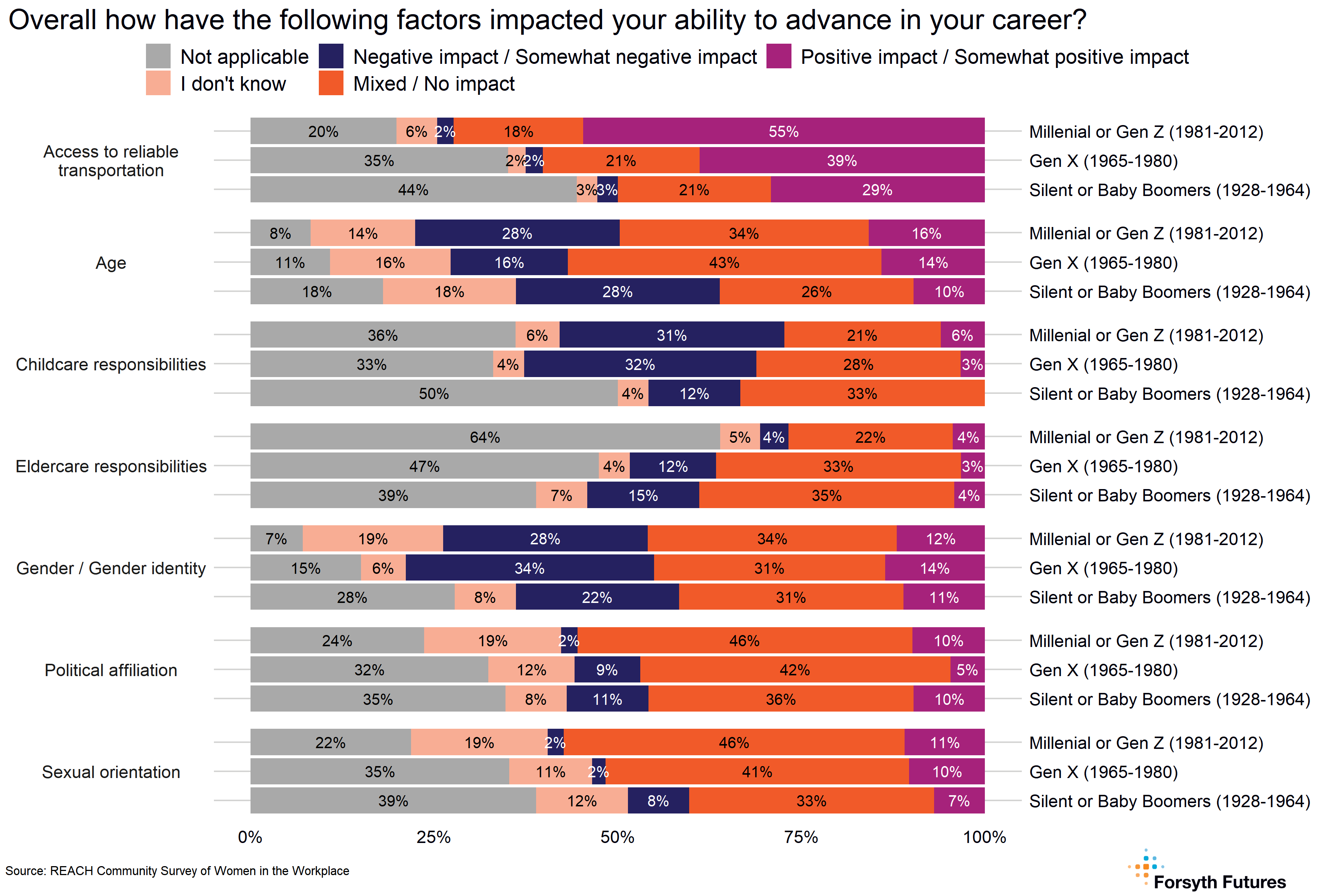
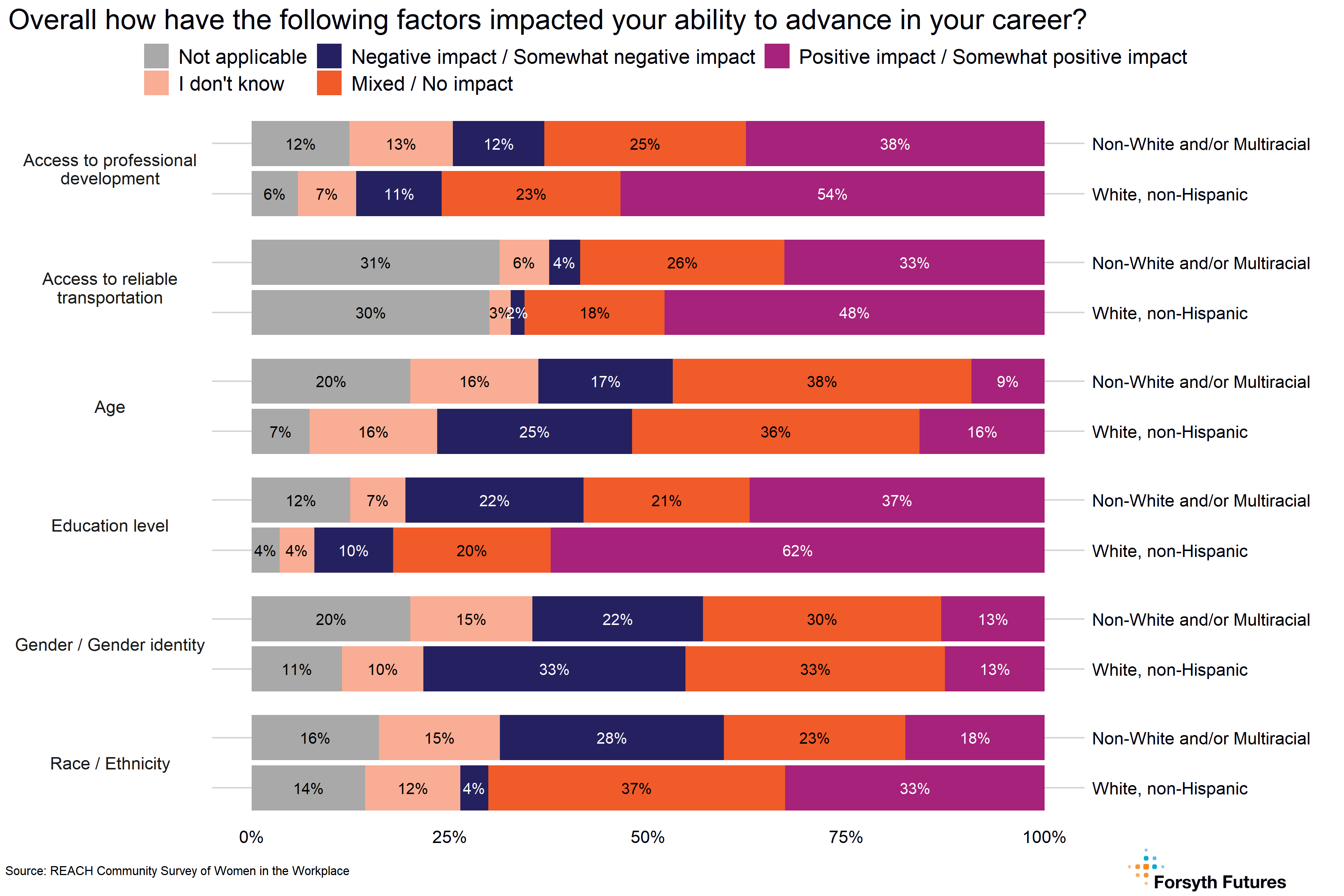
Among the disaggregations, analysts found the following statistically significant relationships between the factors that influence career advancement:
- size of employer
- age
- disability / medical condition
- race / ethnicity and wage income together
- access to professional development
- age
- education level
- gender / gender identity
- race / ethnicity
- sexual orientation
- wage income
- access to professional development
- education level
- gender / gender identity
- sexual orientation
- age / generation
- access to reliable transportation
- age
- child care responsibilities
- eldercare responsibilities
- gender / gender identity
- political affiliation
- sexual orientation
- race / ethnicity
- access to professional development
- access to reliable transportation
- age
- education level
- gender / gender identity
- race / ethnicity
There were not any factors influencing career advancement that consistently had a significant relationship across the disaggregations. However, age did have a statistically significant relationship across all disaggregations except wage income.